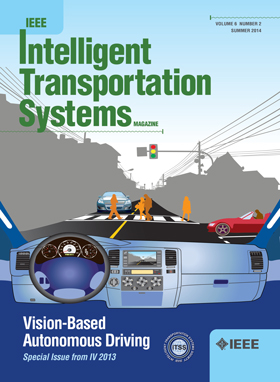基于多智能体强化学习的合作交通信号优先度提高车头时距依从性
IF 7.9
1区 工程技术
Q1 ENGINEERING, CIVIL
IEEE Transactions on Intelligent Transportation Systems
Pub Date : 2025-02-04
DOI:10.1109/TITS.2025.3533603
引用次数: 0
摘要
航向正常与否是衡量公交可靠性的重要指标,直接影响乘客等候时间和公交服务质量。在本文中,我们采用多代理强化学习(MARL)技术,在多交叉路口网络下开发了一种 "配合公交信号优先策略"(CTVH)。每个信号灯路口都由一个 RL 代理控制,该代理决定下一步的信号灯,适应过境和非过境的实时交通动态,并促进遵守公交班次。所提出的方法考虑了四个关键方面,即具有多个冲突公交请求的复杂状态、受领域知识限制的理性行动、平衡公交车和汽车的综合奖励以及代理之间的协作训练方案。相应地,我们采用了适当的状态表示法(估计公交车车头偏离情况)、非理性行动掩蔽法、由一般交通队列和公交车车头偏离情况制定的奖励函数,以及适当的同步行动处理 MARL 方法来解决这些问题。我们的方法还通过设置黄色和全红时间来考虑相位转换损失。与协调固定时间信号(CFT)和公交车保持(BH)策略相比,仿真结果验证了所提方法在改善公交车车头保持率和对一般交通的影响方面的优点。在此基础上,我们进一步讨论了 BH 方法因公交车停靠区长度和各种停靠线路而受到的限制,以及 CTVH 方法在三交叉口环境和全线网络中的优势。所提出的方法在提高公交可靠性方面具有广阔的应用前景。本文章由计算机程序翻译,如有差异,请以英文原文为准。
Multi-Agent Reinforcement Learning for Cooperative Transit Signal Priority to Promote Headway Adherence
Headway regularity is an essential indicator of transit reliability, directly influencing passenger waiting time and transit service quality. In this paper, we employ multi-agent reinforcement learning (MARL) to develop a Cooperative Transit signal priority strategy with Variable phase for Headway adherence (CTVH) under a multi-intersection network. Each signalized intersection is controlled by an RL agent, which determines the next step’s signal, adapting to real-time traffic dynamics of transits and non-transits and promoting transit headway adherence. The proposed approach considers four critical aspects, i.e., complicated states with multiple conflicting bus requests, rational actions constrained by domain knowledge, comprehensive rewards balancing buses and cars, and a collaborative training scheme among agents. They are correspondingly addressed by proper state representation with estimated bus headway deviations, irrational actions masking, reward functions formulated by general traffic queue and transit headway deviation, and appropriate MARL approach with synchronous action processing. Our method also takes into account the phase transition loss by setting yellow and all-red time. Simulation results compared with the coordinated fixed-time signal (CFT) and bus holding (BH) strategy verify the merits of the proposed method in terms of improvements in transit headway adherence and influence on general traffic. Based on the results, we further discuss the BH method’s limitations due to bus bay length and various holding lines and the CTVH method’s benefits in the three-intersection environment and the entire-line network. The proposed method has a promising application in practice to improve transit reliability.
求助全文
通过发布文献求助,成功后即可免费获取论文全文。
去求助
来源期刊

IEEE Transactions on Intelligent Transportation Systems
工程技术-工程:电子与电气
CiteScore
14.80
自引率
12.90%
发文量
1872
审稿时长
7.5 months
期刊介绍:
The theoretical, experimental and operational aspects of electrical and electronics engineering and information technologies as applied to Intelligent Transportation Systems (ITS). Intelligent Transportation Systems are defined as those systems utilizing synergistic technologies and systems engineering concepts to develop and improve transportation systems of all kinds. The scope of this interdisciplinary activity includes the promotion, consolidation and coordination of ITS technical activities among IEEE entities, and providing a focus for cooperative activities, both internally and externally.
 求助内容:
求助内容: 应助结果提醒方式:
应助结果提醒方式:


